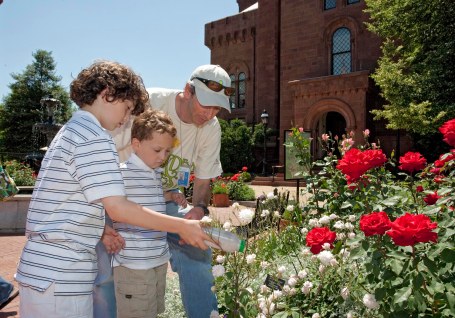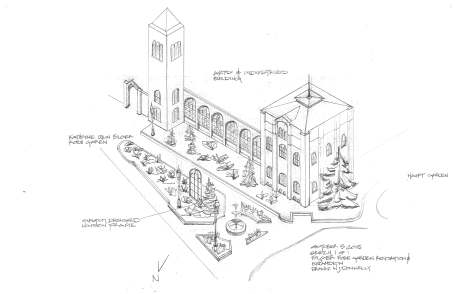Posts tagged ‘roses’
Kathrine Dulin Folger Rose Garden Expansion and Renovation
The Kathrine Dulin Folger Rose Garden has been a treasured component of the Smithsonian landscape since 1998. For nearly two decades it has served as a place to enjoy beauty, learn about modern roses and showcase gardening. This year, the garden will undergo an expansion and renovation to continue that legacy. This exciting project is made possible through a generous grant from the Lee and Juliet Folger Fund.
In addition to physically increasing the garden’s footprint by developing existing turf areas in front of the Smithsonian Arts and Industries Building, the renovation will include the installation of interpretive signage highlighting information about roses as well as the important roles that beneficial insects and companion plants play in the garden. The signage will encourage visitors to more fully appreciate the garden’s four-season design and understand the advantage of variety and balance in nature and in garden design. Smithsonian Gardens will also install a custom-designed garden feature that complements the garden’s Victorian cast iron fountain and urns and ties in with the beautiful architecture of the historic A & I Building.
Many people envision a rose garden as a formal, symmetrical design consisting solely of roses surrounded by tightly-clipped boxwood edges — a near monoculture. While this type of design can be beautiful, it can also lead to an imbalance in the garden. Smithsonian Gardens wanted to design a rose garden that reflects balance as found in nature complete with structural complexity and plant diversity which allows for both pest and pest predator (a.k.a. beneficial insect) populations. By taking this approach we hope to cultivate a healthier garden with a lesser reliance on pesticides.

Young visitors to the Folger Rose Garden learning about the use of beneficial insects for pest management.
The redesigned Folger Rose Garden will embody the best practices in modern rose care and culture. When planning for this project, Smithsonian Gardens staff spent months carefully selecting rose varieties that are fragrant, disease resistant, and–whenever possible–“own-root roses” meaning they are grown from cuttings rather than grafted onto another rootstalk. Good selection is critical to maintaining a beautiful and scented garden without constant disease pressure and pesticide application.
When the Kathrine Dulin Folger Rose Garden was originally designed and installed in 1997-1998, the vision was to create a four-season garden with year-round interest. That vision guides this redesign as well. Roses will bloom in the spring, summer, and fall. A few specimen conifers and evergreens will punctuate and anchor the garden during the winter months but also supply some of the desired structural complexity. A variety of groundcovers and other perennials will add to the display and ensure plant diversity. These companion plants have been chosen specifically for their ability to attract a variety of beneficial insects into the garden, thus aiding in a natural balance and rose protection.
It is our hope that when the Kathrine Dulin Folger Rose Garden reopens in the summer of 2016 it will give visitors the opportunity both to surround themselves with beauty and better understand roses as a part of a larger ecosystem.
-Shelley Gaskins, Horticulturist, Smithsonian Gardens
March 30, 2016 at 9:00 am smithsoniangardens Leave a comment
June is National Rose Month

Glass lantern slide of an unidentified garden, c. 1920. Archives of American Gardens, J. Horace McFarland Collection.
We’re bringing our month of wedding-themed #ThrowbackThursdays to a close with tips for caring for roses at home from Smithsonian Gardens horticulturist Shelley Gaskins. Shelley manages the Kathrine Dulin Folger Rose Garden next to the Smithsonian Castle.
June is one of the most popular months for weddings, and it’s also National Rose Month! Roses are a traditional and elegant flower choice for wedding bouquets and decorations. Did you know that Tricia Nixon was married in the White House Rose Garden in June of 1971? The White House Historical Association has a new exhibit exploring the Rose Garden during the Kennedy administration opening on July 16th. “The Kennedy Rose Garden: Traditionally American” features a few photographs and letters from the Archives of American Gardens. Did you choose roses for your wedding? Share your story in the comments!

‘Amber Queen.’ This rose, and all of the roses pictured below, can be found growing in the Kathrine Dulin Folger Rose Garden next to the Smithsonian Castle in Washington, D.C.
Rose Tip #1: Do your research! Roses are rated on several characteristics. Choosing roses that are rated as resistant to fungal diseases such as black spot and powdery mildew should top your list.
Rose Tip #2: Roses require at least 6 hours of full sun (preferably in the morning), a well-drained and nutrient-rich soil, and moderate amounts of water. Water should only be applied directly to the root zone, not to the leaf surface. Adequate sunlight and water will help decrease the spread and incidence of fungal diseases.
Rose Tip #3: When pruning roses in early spring, prune with the understanding that opening up the center of the plant allows for light penetration and air circulation. Allowing light and air into the center of the plant will create an environment that is less favorable to fungal diseases. Be sure to clean the edge of your pruners with alcohol to avoid spreading viruses.
Rose Tip #4: Eliminating dead, dying and diseased plants and plant parts from your garden will help to keep your garden healthy. This includes cleaning up potentially diseased rose leaves that have fallen from the plant. Fungal spores can overwinter and return to the plant from the fallen leaves.
Rose Tip #5: Not all bugs are bad! get to know the insects that visit your garden. Find out which insects truly pose a threat to the health of your plants (pests). Find out if the pest has any natural predators (beneficial insects). A healthy garden should have both. If necessary, you can introduce mail-order beneficial insects into your garden.
Rose Tip #6: Beneficial insects are often beneficial only at certain stages in their life cycle. For example, the syrphid fly only feeds on prey while they’re in their larval stage. Adult syrphids don’t eat other insects, they eat nectar and pollen. You should plant flowers that provide a variety of nectar and pollen sources throughout the growing season.
Rose Tip #7: Last one! Plant families that will help attract beneficial insects to your rose garden, including:
- Apiaceae (or Umbelliferae) -Carrot Family- attracts lady bugs, parasitic wasps, and predatory flies.
- Lamiaceae or Labiatae -Mint family
- Asteraceae -Daisy Family- attracts hoverflies, lacewing, lady bug beetles, minute pirate bugs, and spiders.
The Modern Rose
Roses are grouped into three types: species, old garden roses, and modern roses. This classification system is based on their existence in the wild, as with species roses, or their date of introduction. The year 1867 heralded the introduction of what is generally accepted as the first modern rose, in this case a hybrid tea rose. This first hybrid tea rose,”La France,” was bred in France by Jean Guillot. “La France” was an offspring of the old garden, hybrid perpetual rose named “Madame Victor Verdier” and the old garden, tea rose “Madame Bravy.” “La France” was special because of its urn-shaped, high centered flowers. This new flower form was remarkably different from those that came before it, thus necessitating a new class. This new class of roses was ultimately named hybrid teas. Hybrid tea roses and the rose classes introduced after 1867 make up the modern rose group.

Crimson Bouquet Grandiflora Rose in Smithsonian Gardens Katherine Dulin Folger Rose Garden
In addition to hybrid teas, polyanthas (a cross between Rosa multiflora and hybrid teas), floribundas (a cross of polyanthas with hybrid teas), grandifloras (resulting from crossing hybrid teas and floribundas), miniatures, and English roses are also considered “modern roses.” All but two of the roses in the Folger Rose Garden fall into these categories and are therefore modern. The exceptions–a hybrid perpetual rose and a tea rose–were included to demonstrate the old garden rose classes that were the precursors to the hybrid tea rose and hence to the “modern rose.”
Shelley Gaskins, Smithsonian Gardens Horticulturist
A Modern Rose Garden
The Kathrine Dulin Folger Rose Garden is a modern rose garden. What makes it modern? The roses? The design? The answer is both.

Eric Long, Smithsonian Photographer
The Roses:
Roses are grouped into three types: species, old garden roses, and modern roses. This classification system is based on their existence in the wild, as with species roses, or their date of introduction. The year 1867 heralded the introduction of what is generally accepted as the first modern rose, in this case a hybrid tea rose. This first hybrid tea rose, named „La France,‟ was bred in France by Jean Guillot. „La France‟ was an offspring of the old garden, hybrid perpetual rose named „Madame Victor Verdier‟ and the old garden, tea rose „Madame Bravy.‟ „La France‟ was special because of its urn-shaped, high centered flowers. This new flower form was remarkably different from those that came before it, thus necessitating a new class. This new class of roses was ultimately named hybrid teas. Hybrid tea roses and the rose classes introduced after 1867 make up the modern rose group.
In addition to hybrid teas, polyanthas (a cross between Rosa multiflora and hybrid teas), floribundas (a cross of polyanthas with hybrid teas), grandifloras (resulting from crossing hybrid teas and floribundas), miniatures, and English roses are also considered “modern roses.” All but two of the roses in the
Folger Rose Garden fall into these categories and are therefore modern. The exceptions–a hybrid perpetual rose and a tea rose–were included to demonstrate the old garden rose classes that were the precursors to the hybrid tea rose and hence to the “modern rose.”
The Design:
The modern rose deserves a modern garden. In this case a modern rose garden is one that works for the roses, not against them. When asked to envision a rose garden, many see a formal, symmetrical design, consisting solely of roses surrounded by boxwood edges and tightly clipped hedges–a near monoculture. While this type of design can be beautiful and fulfills a need for a sense of order, it can also lead to an imbalance in the garden. Balance, as found in nature, is made possible by structural complexity and plant diversity which allow for both pest and pest predator (a.k.a. beneficial insects) populations. A modern rose garden should strive for this type of balance as it will lead to a healthier garden with a lesser reliance on pesticides.
When the Kathrine Dulin Folger Rose Garden was designed and installed in 1997-1998, the vision was of a four season garden with year-round interest. That vision still remains a guiding light for Smithsonian Gardens‟ horticulturists today. Roses bloom in the spring through the fall. Small collections of boxwood and holly not only anchor the garden during the winter months but also supply some of the desired structural complexity. A variety of ground covers and other perennials add to the display and ensure plant diversity. They were chosen specifically for their ability to attract a variety of beneficial insects into the garden, thus aiding in a natural balance.
The Kathrine Dulin Folger Rose Garden is a garden of modern roses that was designed with modern garden ideals in mind. As modern as these garden ideals are, however, they hearken back to ancient ideals of nature. Everything old is new again! Or, more fittingly for speaking of gardens, there is nothing new under the sun.







